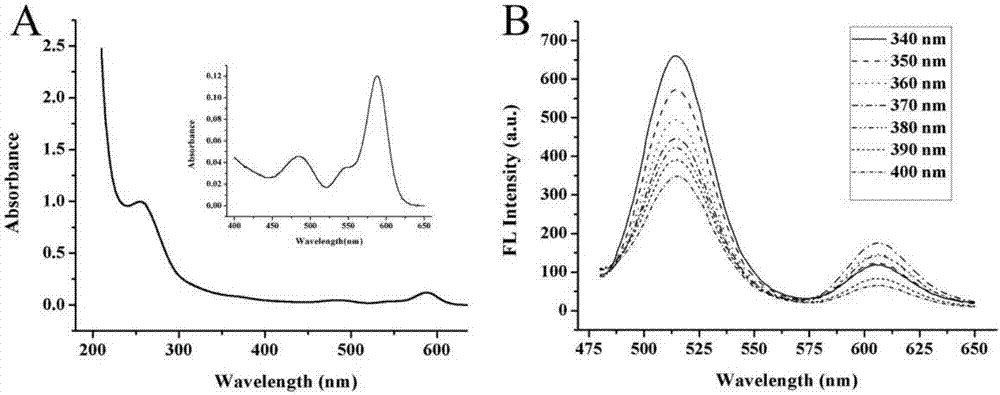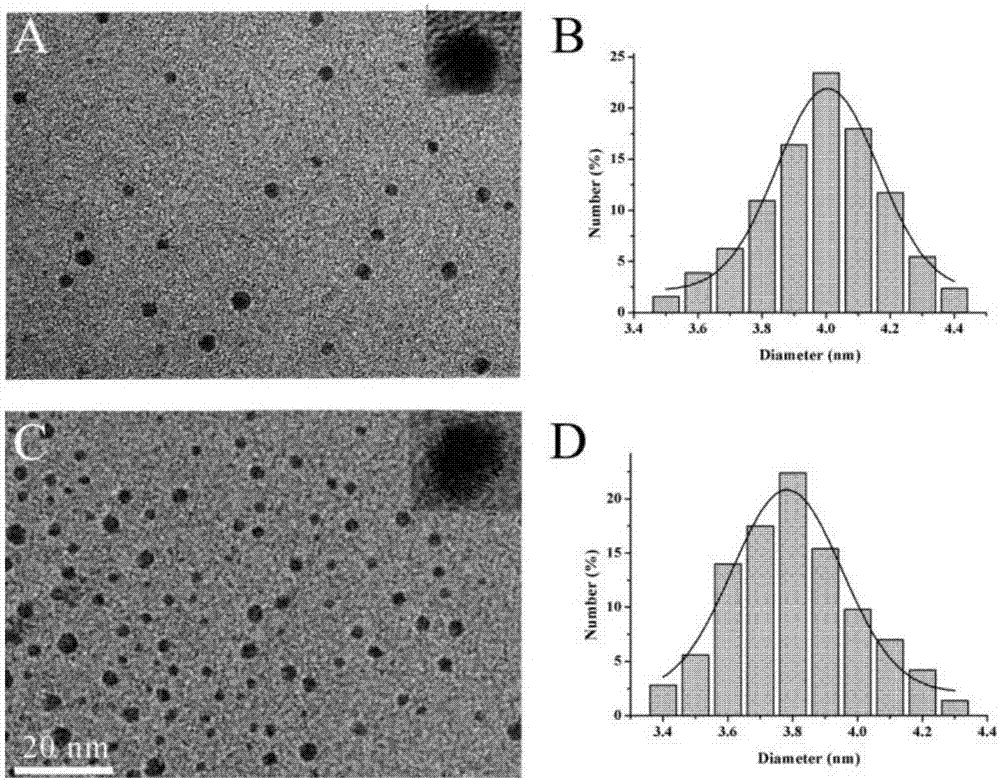Method for synthesizing dye modified DNA (Deoxyribonucleic Acid) functionalized cadmium-containing quantum dots and application of quantum dots
A technology for synthesizing dyes and a method for synthesizing dyes is applied in the field of synthesizing dye-modified DNA functionalized cadmium-containing quantum dots. The effect of application range, low cost and simple preparation method
- Summary
- Abstract
- Description
- Claims
- Application Information
AI Technical Summary
Problems solved by technology
Method used
Image
Examples
Embodiment 1
[0054] [Example 1] A method for fluorescent dye modification of DNA functionalized CdZnTeS quantum dots
[0055] The synthesis method includes the following steps:
[0056] 1) Dissolve 0.025 mmol cadmium chloride, 0.025 mmol zinc chloride and 0.05 mmol N-acetyl-L-cysteine in deionized water to obtain mixed solution A, adjust the pH value of mixed solution A with sodium hydroxide solution To 10.0, add 0.01mmol sodium tellurite and 0.005mmol 2,3-dimercaptosuccinic acid, then adjust the pH value of mixed solution B to 11.0 with sodium hydroxide solution, and finally add 80 nmol dye and phosphorothioate together The modified DNA was stirred evenly and transferred to a hydrothermal reactor, and reacted at 200 ℃ for 18 min to obtain fluorescent dye modified DNA functionalized CdZnTeS quantum dots;
[0057] The said DNA was designed by the inventor and handed over to Shanghai Shenggong for synthesis. Its 5'end is modified with phosphorothioate and the 3'end is modified with a dye. The nu...
Embodiment 2
[0060] [Example 2] A method of CdZnTeS quantum dots
[0061] The synthesis method includes the following steps:
[0062] 1) Dissolve 0.025 mmol cadmium chloride, 0.025 mmol zinc chloride and 0.05 mmol N-acetyl-L-cysteine in deionized water to obtain mixed solution A, adjust the pH value of mixed solution A with sodium hydroxide solution To 10.0, add 0.02mmol sodium tellurite and 0.01mmol 2,3-dimercaptosuccinic acid, then adjust the pH value of the mixed solution B to 11.0 with sodium hydroxide solution, stir well and transfer to the hydrothermal reactor. React at 200 ℃ for 18 min to obtain CdZnTeS quantum dots;
[0063] 2) Centrifugally purify the obtained CdZnTeS quantum dot solution with an ultrafiltration tube with a molecular retention of 30,000. Pour out the waste liquid and add ultrapure water for washing and centrifugation. This cycle of washing and centrifugation is 4 times, and the ultrafiltration tube is inverted. Centrifuge to obtain pure CdZnTeS quantum dots, store th...
Embodiment 3
[0065] [Example 3] A fluorescent dye modified DNA functionalized CdTe:Zn 2+ Quantum dot method
[0066] The synthesis method includes the following steps:
[0067] 1) Dissolve 0.025 mmol cadmium chloride, 0.05 mmol zinc chloride and 0.05 mmol N-acetyl-L-cysteine in deionized water to obtain mixed solution A, adjust the pH value of mixed solution A with sodium hydroxide solution To 9.0. Dissolve 0.01 mmol of sodium tellurite and 0.005 mmol of sodium borohydride in 1 mL of deionized water, fill with nitrogen for 1 min to remove oxygen, and react in an ice bath for 5-7 h to obtain a colorless or light pink liquid B. Take 400 µL of mixed solution A, add 80 nmol of DNA modified by dye FAM and phosphorothioate, use deionized water to make the entire solution volume 2 mL, which is mixed solution C, and finally take 5 µL of colorless liquid B and quickly add 2 In mL of mixed solution C, stir evenly and transfer to a hydrothermal reactor, and react at 200 ℃ for 26 min to obtain fluoresc...
PUM
| Property | Measurement | Unit |
|---|---|---|
| diameter | aaaaa | aaaaa |
Abstract
Description
Claims
Application Information
 Login to View More
Login to View More - R&D
- Intellectual Property
- Life Sciences
- Materials
- Tech Scout
- Unparalleled Data Quality
- Higher Quality Content
- 60% Fewer Hallucinations
Browse by: Latest US Patents, China's latest patents, Technical Efficacy Thesaurus, Application Domain, Technology Topic, Popular Technical Reports.
© 2025 PatSnap. All rights reserved.Legal|Privacy policy|Modern Slavery Act Transparency Statement|Sitemap|About US| Contact US: help@patsnap.com



